Dr. Huan-Xiang Zhou
Professor, Ph.D., Drexel University, 1988Professor Huan-Xiang Zhou obtained his Ph.D from Drexel in 1988.
His research interests include:
Protein Interactions
Interactions of proteins among themselves and with other molecules such as DNA, RNA, and membranes are essential for biological functions. Our research aims to gain fundamental understanding of the determinants of binding affinity and binding rates. Based on statistical mechanics, we develop physical models that can be implemented on the computer to realistically predict binding properties. An example is the transition-state theory we developed to predict the enhancement of protein association rates by electrostatic interactions. Other questions being addressed include calculation of absolute binding affinity and the relation of intermolecular and intramolecular binding. Molecular dynamics simulations are carried out to elucidate the mechanisms of protein-protein association.
Using knowledge accumulated from the interfaces of known protein-protein and protein-DNA complexes, we have developed neural-network methods, cons-PPISP and Displar, for predicting interfaces residues. The methods promise to complement experimental methods such as chemical-shift perturbations for characterizing interfaces. Among other applications, these methods are used to generate data which are used to driving docking and to filter docking results. This use of cons-PPISP has found successes in recent rounds of CAPRI ("Critical Assessment of PRediction of Interactions").
Protein Folding
The folding of a protein molecule can be viewed as the accumulation of native contacts. Based on modeling the unfolded protein molecule as a polymer chain, we have developed a theory for the rate of forming native contacts. This theory is now being extended and applied to study folding processes such as beta-hairpin and coiled-coil formation. In addition, molecular dynamics simulations of protein unfolding are carried out to elucidate the transition state of folding.
Protein Stability
The major stabilizing forces of protein structures are hydrophobic and electrostatic. While there is consensus on the hydrophobic contributions, the roles of electrostatic interactions in protein stability have been uncertain. We have made significant progress in modeling electrostatic effects. We are now developing better solvation models using as benchmarks experimental data and molecular dynamics simulations with explicit solvent and investigating effects of charges and electrostatic interactions in protein folding, binding, aggregation, and amyloid formation.
Chain entropy opposes the folded state, therefore proteins can be stabilized by reducing the chain entropy loss upon folding. We have elucidated the physical bases for a number of such entropy-based stabilization strategies, including spatial confinement and backbone cyclization. Experiments are underway to test and refine the theoretical models.
Theory and Experiment: Complementary Approaches
In the past few years our group has added experimental approaches to complement our theoretical studies. We are investigating the physical basis of protein stability, the mechanisms of protein folding, and the determinants of protein binding stability. Many of our experimental investigations are motivated by our theoretical developments. The interplay between theory and experiment is providing a powerful advantage in advancing our understanding of protein structure and function.
 |